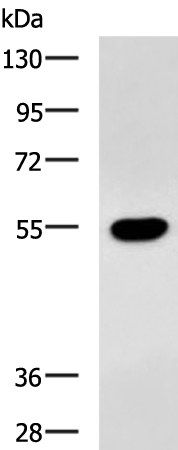
| WB | 咨询技术 | Human,Mouse,Rat |
| IF | 咨询技术 | Human,Mouse,Rat |
| IHC | 咨询技术 | Human,Mouse,Rat |
| ICC | 技术咨询 | Human,Mouse,Rat |
| FCM | 咨询技术 | Human,Mouse,Rat |
| Elisa | 1/5000-1/10000 | Human,Mouse,Rat |
| Aliases | V28; CCRL1; GPR13; CMKDR1; GPRV28; CMKBRL1 |
| WB Predicted band size | 40 kDa |
| Host/Isotype | Rabbit IgG |
| Antibody Type | Primary antibody |
| Storage | Store at 4°C short term. Aliquot and store at -20°C long term. Avoid freeze/thaw cycles. |
| Species Reactivity | Human, Mouse |
| Immunogen | Synthetic peptide of human CX3CR1 |
| Formulation | Purified antibody in PBS with 0.05% sodium azide and 50% glycerol. |
+ +
以下是关于CX3CR1抗体的3篇文献参考及摘要概括:
---
1. **文献名称**:CX3CR1 mediates microglial neurotoxicity in a mouse model of Parkinson’s disease
**作者**:Jung, S. et al.
**摘要**:该研究利用CX3CR1抗体进行免疫组化染色和流式细胞术,发现CX3CR1在小胶质细胞中高表达,并证实其缺失可减轻帕金森病模型中的神经炎症和多巴胺能神经元损伤,揭示了CX3CR1在神经退行性疾病中的关键作用。
2. **文献名称**:CX3CR1 distinguishes monocyte subsets with divergent functions in atherosclerosis
**作者**:Hanna, R.N. et al.
**摘要**:通过CX3CR1抗体对单核细胞亚群进行分型,研究发现高表达CX3CR1的单核细胞具有更强的迁移能力,并促进动脉粥样硬化斑块形成,为靶向CX3CR1治疗心血管疾病提供了依据。
3. **文献名称**:Microglial CX3CR1 signaling modulates neuronal survival in a mouse model of Alzheimer’s disease
**作者**:Wolf, Y. et al.
**摘要**:采用CX3CR1抗体阻断实验和基因敲除模型,发现CX3CR1介导小胶质细胞与神经元的相互作用,其功能缺失加剧β-淀粉样蛋白沉积和认知障碍,提示其在阿尔茨海默病中的保护性角色。
---
以上文献涵盖了CX3CR1抗体在神经退行性疾病、免疫细胞分型及机制研究中的应用,可作为相关领域的实验设计参考。如需具体期刊信息或补充内容,可进一步检索PubMed或Web of Science数据库。
CX3CR1 (C-X3-C motif chemokine receptor 1) is a G protein-coupled receptor that binds to its sole ligand, CX3CL1 (fractalkine), mediating cell adhesion, migration, and immune responses. It is predominantly expressed on microglia, monocytes, dendritic cells, and certain T-cell subsets. CX3CR1 plays critical roles in neuroinflammation, leukocyte trafficking, and tissue homeostasis, with implications in neurodegenerative diseases (e.g., Alzheimer’s disease), atherosclerosis, and autoimmune disorders.
CX3CR1 antibodies are essential tools for detecting and quantifying receptor expression in research. They enable visualization of CX3CR1+ cell populations via techniques like flow cytometry, immunohistochemistry, and Western blotting. These antibodies also facilitate functional studies, such as blocking receptor-ligand interactions to assess downstream signaling or cellular behaviors. Commercially available CX3CR1 antibodies are typically raised in hosts like rabbits or mice, targeting specific extracellular or intracellular epitopes. Validation includes knockout controls and ligand-binding inhibition assays to ensure specificity.
Research using CX3CR1 antibodies has revealed its dual role in inflammation: promoting microglial neuroprotection in early neurodegeneration while exacerbating damage in chronic phases. In cancer, CX3CR1 expression on tumor-associated macrophages correlates with metastasis and immunosuppression. Recent therapeutic strategies explore modulating CX3CR1/CX3CL1 axis to treat neurological or inflammatory diseases. However, challenges remain in distinguishing receptor isoforms and avoiding cross-reactivity with structurally similar chemokine receptors.
×